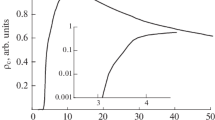Abstract
The application of a sufficiently strong magnetic field to a superconductor will, in general, destroy the superconducting state. Two mechanisms are responsible for this. The first is the Zeeman effect1,2, which breaks apart the paired electrons if they are in a spin-singlet (but not a spin-triplet) state. The second is the so-called ‘orbital’ effect, whereby the vortices penetrate into the superconductors and the energy gain due to the formation of the paired electrons is lost3. For the case of layered, two-dimensional superconductors, such as the high-Tc copper oxides, the orbital effect is reduced when the applied magnetic field is parallel to the conducting layers4. Here we report resistance and magnetic-torque experiments on single crystals of the quasi-two-dimensional organic conductor λ-(BETS)2FeCl4, where BETS is bis(ethylenedithio)tetraselenafulvalene5,6,7,8. We find that for magnetic fields applied exactly parallel to the conducting layers of the crystals, superconductivity is induced for fields above 17 T at a temperature of 0.1 K. The resulting phase diagram indicates that the transition temperature increases with magnetic field, that is, the superconducting state is further stabilized with magnetic field.



Similar content being viewed by others
References
Chandrasekhar, B. S. A note on the maximum critical field of high-field superconductors. Appl. Phys. Lett. 1, 7–8 (1962).
Clogston, A. M. Upper limit for the critical field in hard superconductors. Phys. Rev. Lett. 15, 266–267 (1962).
Tinkham, M. Introduction to Superconductivity (McGraw-Hill, New York, 1975).
Klemm, R. A., Luther, A. & Beasley, M. R. Theory of the upper critical field in layered superconductors. Phys. Rev. B 12, 877–891 (1975).
Brossard, L. et al. Interplay between chains of S = 5/2 localised spins and two-dimensional sheets of organic donors in the synthetically built magnetic multilayer λ-(BETS)2FeCl4. Eur. Phys. J. B 1, 439–452 (1998).
Kobayashi, H. et al. New BETS conductors with magnetic anions (BETS=bis(ethylenedithio)tetraselenafulvalene). J. Am. Chem. Soc. 118, 368–377 (1996).
Kobayashi, H. et al. Electric and magnetic properties and phase diagram of a series of organic superconductors λ-(BETS)2GaXZY1-z [X, Y=F, Cl, Br; 0 < z < 2]. Phys. Rev. B 56, R8526–R8529 (1997).
Akutsu, H. et al. Highly correlated organic conductor with magnetic anions exhibiting a π-d coupled metal-insulator transition, λ-(BETS)2FeBrxCl1-x. J. Am. Chem. Soc. 119, 12681–12682 (1997).
Brooks, J. S., Naughton, M. J., Ma, Y. P., Chaikin, P. M. & Chamberlin, R. V. Small sample magnetometers for simultaneous magnetic and resistive measurements at low temperatures and high magnetic fields. Rev. Sci. Instrum. 58, 117–121 (1987).
Meul, H. W. et al. Observation of magnetic-field-induced superconductivity. Phys. Rev. Lett. 53, 497–500 (1984).
Jaccarino, V. & Peter, M. Ultra-high-field superconductivity. Phys. Rev. Lett. 9, 290–292 (1962).
Lebed, A. G. Reversible nature of the orbital mechanism for the suppression of superconductivity. JETP Lett 44, 114–117 (1986).
Dupuis, N., Montambaux, G. & Sa de Melo, C. A. R. Quasi-one-dimensional superconductors in strong magnetic field. Phys. Rev. Lett. 70, 2613–2616 (1993).
Miyazaki, M., Kishigi, K. & Hasegawa, Y. Superconductivity of quasi-one- and quasi-two-dimensional tight binding electrons in a magnetic field. J. Phys. Soc. Jpn 67, 2618–2621 (1998).
Shimahara, H. Coexistence of singlet and triplet attractive channels in the pairing interactions mediated by antiferromagnetic fluctuations. J. Phys. Soc. Jpn 69, 1966–1969 (2000).
Sa de Melo, C. A. R. Paramagnetism and reentrant behaviour in quasi-one-dimensional superconductors at high magnetic fields. Physica C 260, 224–230 (1996).
Tanatar, M. A. et al. Anisotropy of the upper critical field of the organic conductor λ-(BETS)2GaCl4. J. Supercond. 12, 511–514 (1999).
Author information
Authors and Affiliations
Corresponding author
Rights and permissions
About this article
Cite this article
Uji, S., Shinagawa, H., Terashima, T. et al. Magnetic-field-induced superconductivity in a two-dimensional organic conductor. Nature 410, 908–910 (2001). https://doi.org/10.1038/35073531
Received:
Accepted:
Issue Date:
DOI: https://doi.org/10.1038/35073531
- Springer Nature Limited
This article is cited by
-
Field-induced compensation of magnetic exchange as the possible origin of reentrant superconductivity in UTe2
Nature Communications (2024)
-
Pauli-limit violation and re-entrant superconductivity in moiré graphene
Nature (2021)
-
A chromium(III) bis-acetylide complex containing a trans-diethyl-ethylenedithio-substituted tetrathiafulvalene (TTF) derivative: synthesis, crystal structures, and magnetic properties
Transition Metal Chemistry (2021)
-
Pauli-limit upper critical field of high-temperature superconductor La1.84Sr0.16CuO4
Scientific Reports (2019)
-
Extreme magnetic field-boosted superconductivity
Nature Physics (2019)





